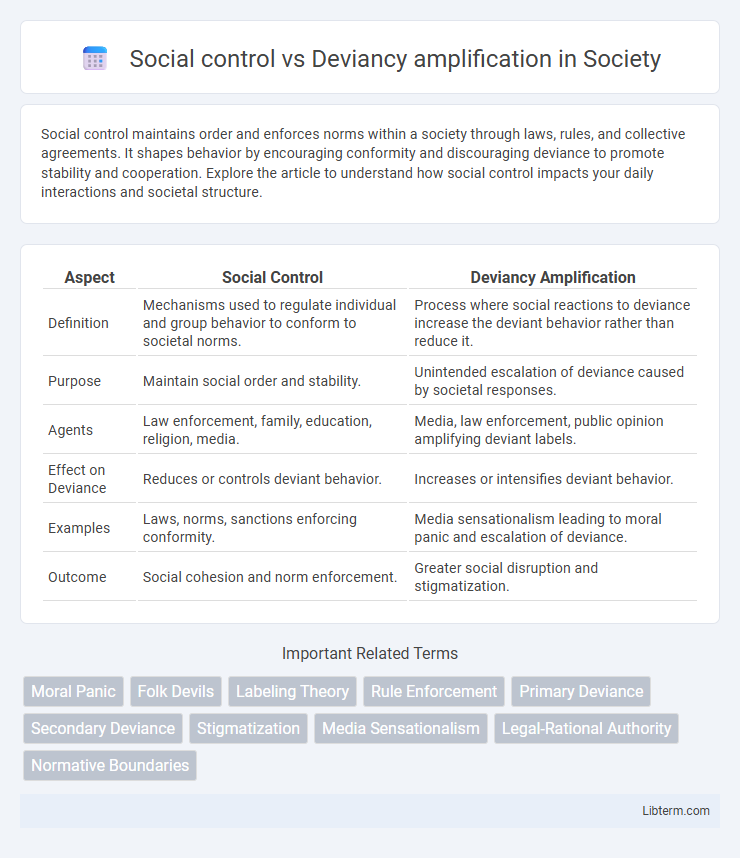Social control maintains order and enforces norms within a society through laws, rules, and collective agreements. It shapes behavior by encouraging conformity and discouraging deviance to promote stability and cooperation. Explore the article to understand how social control impacts your daily interactions and societal structure.
Table of Comparison
| Aspect | Social Control | Deviancy Amplification |
|---|---|---|
| Definition | Mechanisms used to regulate individual and group behavior to conform to societal norms. | Process where social reactions to deviance increase the deviant behavior rather than reduce it. |
| Purpose | Maintain social order and stability. | Unintended escalation of deviance caused by societal responses. |
| Agents | Law enforcement, family, education, religion, media. | Media, law enforcement, public opinion amplifying deviant labels. |
| Effect on Deviance | Reduces or controls deviant behavior. | Increases or intensifies deviant behavior. |
| Examples | Laws, norms, sanctions enforcing conformity. | Media sensationalism leading to moral panic and escalation of deviance. |
| Outcome | Social cohesion and norm enforcement. | Greater social disruption and stigmatization. |
Understanding Social Control: Definition and Purpose
Social control refers to the mechanisms, strategies, and institutions societies use to regulate individual and group behavior, ensuring conformity to established norms and laws. Its purpose is to maintain social order, prevent deviance, and promote social cohesion by reinforcing accepted standards of conduct. Through formal means like law enforcement and informal processes such as socialization, social control shapes behavior and supports societal stability.
Deviancy Amplification: Concept and Origins
Deviancy amplification refers to the process by which attempts to control or suppress deviant behavior inadvertently increase its occurrence or visibility, often through heightened media attention or public reaction. This concept originated from sociologists studying moral panics, particularly Stanley Cohen's seminal work on the "folk devils" and media portrayal of the Mods and Rockers in 1970s Britain. The theory emphasizes the cyclical relationship between societal reactions and deviance, where control efforts can exacerbate the social problem they aim to reduce.
Historical Context of Social Control Mechanisms
Social control mechanisms have evolved through history from rigid legal codes and religious edicts to more sophisticated institutional regulations, reflecting society's need to maintain order and conformity. During the 19th and 20th centuries, the rise of mass media played a pivotal role in shaping public perceptions and influencing social norms, often contributing to deviancy amplification by sensationalizing behavior deemed deviant. Historical instances such as the moral panic around the Mods and Rockers in 1960s Britain exemplify how social control efforts can inadvertently intensify deviant labeling and escalation.
The Role of Media in Deviancy Amplification
Media plays a crucial role in deviancy amplification by sensationalizing deviant behavior, which often leads to heightened public fear and moral panic. This amplification effect occurs as media coverage exaggerates the prevalence and severity of deviant acts, influencing social responses and increasing social control measures. Consequently, distorted media portrayals can perpetuate stereotypes and escalate social tensions, reinforcing deviant identities rather than mitigating deviance.
Key Theories: Moral Panics and Labeling
Social control mechanisms often trigger deviancy amplification through processes explained by Moral Panics and Labeling theories. Moral Panics theory highlights how media and authorities exaggerate threats, causing public fear and stricter social controls that increase deviant behavior visibility. Labeling theory emphasizes how stigmatizing individuals as deviants can reinforce deviant identities and escalate rule-breaking actions.
Agents of Social Control: Institutions and Influence
Agents of social control such as law enforcement, education systems, and media institutions enforce norms and regulate behavior to maintain societal order. These institutions influence public perception by defining deviance, which can inadvertently amplify deviant behavior through stigmatization and increased visibility. A feedback loop occurs when heightened social control measures lead to greater deviance, demonstrating the complex relationship between institutional influence and deviancy amplification.
Case Studies: Real-World Examples of Deviancy Amplification
Deviancy amplification describes how media and law enforcement responses to minor deviant behavior can inadvertently escalate public concern and social control measures, as seen in the 1960s Mods and Rockers clashes in the UK where sensationalist reporting intensified youth disorder. The "Moral Panic" around the 1980s UK National Front also exemplifies this, with amplified media coverage leading to increased police presence and stricter controls on political protests. Case studies like the 1990s US "superpredator" myth show how exaggerated narratives about juvenile crime prompted harsher sentencing laws, further entrenching social control rather than resolving underlying social issues.
Social Control vs. Deviance: Points of Tension
Social control mechanisms aim to regulate behavior and maintain social order, but they sometimes intensify deviancy amplification by stigmatizing individuals and reinforcing outsider status. Labeling theory explains how the reaction of social control institutions can escalate deviant behavior rather than reduce it, creating a cycle of increased deviance. These points of tension reveal the paradox where efforts to control deviance inadvertently contribute to the expansion of deviant subcultures and behaviors.
Impacts on Society: Consequences of Amplified Deviance
Deviancy amplification intensifies social deviance by escalating public fear and reinforcing negative stereotypes, leading to harsher social control measures and increased marginalization of targeted groups. This cyclical process often results in over-policing and stigmatization, which undermine community trust and social cohesion. Heightened deviance perception triggers policy responses that may exacerbate social inequalities and foster environments conducive to further deviant behavior.
Navigating the Balance: Mitigating Unintended Outcomes
Effective social control strategies must carefully balance maintaining order while avoiding deviancy amplification, where increased enforcement unintentionally escalates deviant behavior. Employing proportional responses and community-based interventions helps mitigate negative feedback loops and fosters social cohesion. Data-driven evaluations enable policymakers to adjust tactics, ensuring enforcement deters rather than exacerbates deviance.
Social control Infographic

 libterm.com
libterm.com